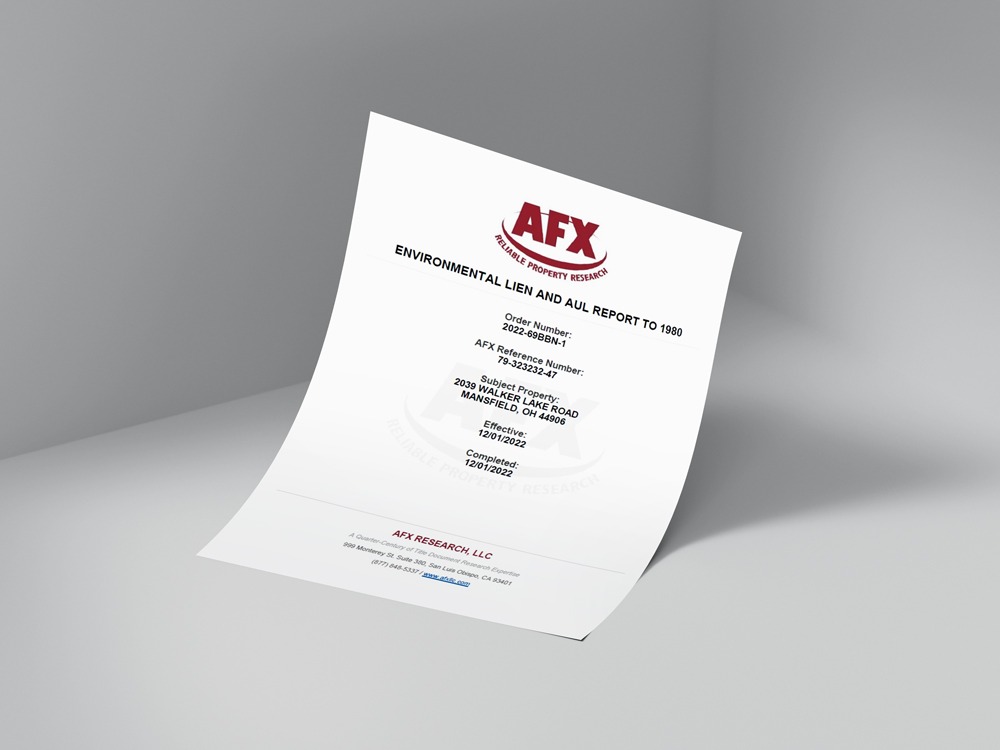Aside from providing clarity on CERCLA liability protection, important guidelines concerning environmental due diligence include EPA's All Appropriate Inquiry (AAI) rule and the ASTM standards E1527-13 and E1527-21. These rules support informed decisions by buyers, investors, and developers about the potential for environmental risk in virtually any type of real estate transaction. Among the key requirements under such standards include the identification of Environmental Liens and Activity and Use Limitations (AULs) that may affect a property with respect to environmental liabilities or constraints on its use.
A key component of most Phase I Environmental Site Assessments (ESA) involves research regarding environmental liens and AULs that are, or may be, attached to the property. This report, entitled an Environmental Lien and AUL Report, can help to determine the legal restrictions and potential liabilities associated with properties before the transactions are finalized.
AFX provides expert Environmental Lien and AUL Reports to ASTM standards, capable of going back to 1980. These reports are utilized nationwide for over 1,000 sites on a month-to-month basis by environmental professionals who serve to meet due diligence requirements for Phase I Environmental Site Assessments.
In this article, we are going to discuss the significance of both Environmental Lien and AUL Report, the ways of effective searching, and how AFX's services support observance of environmental due diligence standards.What are Environmental Liens and Activity and Use Limitations (AULs)?
Before delving into the details of the services offered by AFX, it is important to outline what Environmental Liens and Activity and Use Limitations are, and why they are so crucial in a Phase I ESA.
New: a product offering for environmental lien search to 1980
Environmental Lien summary
AUL summary
Legal Description of property
Deed recording information (book, page, date, grantor and grantee)
List of all locations research to complete the report

An environmental lien is an encumbrance given against a subject property that has been placed by a governmental agency or third party due to costs of environmental remediation. These types of liens can be filed against properties when their owners are deemed responsible for environmental contamination and subsequent cleanup required. The purpose of the lien is for recovery of costs associated with the environmental cleanup, possibly including hazardous waste removal, soil remediation, or even groundwater treatment.
It follows that, because some type of environmental damage has occurred on the property, an environmental lien reflects the owner's responsibility for cleanup costs associated with it. To a potential purchaser, an environmental lien means financial liability since the lien could impact the property even after it has passed to a different owner.
Activity Use Limitations are legal restrictions or limitations placed on the use of a property as a result of environmental contamination. AULs can be generated in many forms that include but are not limited to land-use restrictions, such as prohibition of residential development; restriction of excavation and other construction activities. An AUL is meant to ensure that any residual contamination that remains on the property does not cause human health or environmental harm.
AULs can be part of a risk-based remediation approach where contaminated active soil is contained on-site rather than removed. This decreases the direct cleanup costs; however, the continuing limitations on property use are retained. These are disclosed and understood during a Phase I ESA as these may affect a future development plan or property value.

Environmental liens and AULs are required to be investigated with respect to properties being appraised under the Phase I ESA procedure, according to EPA's AAI rule in conjunction with the ASTM E1527-13 and E1527-21 standards. Evaluation plays a vital role in inspecting or making an inference about the possibility of the occurrence of environmental liability linked with a property. In case such liens or AULs are present, they become a prerequisite before the actual consummation of a real estate transaction.
Generally, Phase I ESAs are required in the following contexts:
This is through an environmental consultant identifying recognized environmental conditions or concerns that have the potential to impact the property. For this to be done effectively, there must be comprehensive information as to the history, use, and legal restrictions of the property in question.
This places the buyer or investor in danger of undertaking very expensive cleanup efforts or extreme limitations on how the property may be enjoyed or developed without a complete environmental lien and AUL search. Therefore, the comprehensive Environmental Lien and AUL Report shall avail them of all the information needed to appreciate both the environmental liabilities of the property in question and the legal restrictions.
AFX provides full Environmental Lien and AUL Reports to current ASTM standards. Our research relies on tangible official documents available at governmental repositories where, with our experience and technology, we capture any and all relevant information found about the subject property.
Environmental liens and AULs are commonly recorded in many government databases and repositories. AFX researchers will conduct thorough searches of the following governmental levels:
AFX provides both Grantor/Grantee indexes and conducts a thorough search of documents recorded against the subject parcel for the presence of environmental liens or AULs. Our research extends from the date the current owner acquired the property up to the present, ensuring continuous coverage of all legal matters. Additionally, where required by law, we search judicial records to identify any court-ordered liens or legal actions that may affect the property.
AFX offers both standard environmental lien report searches and reports prepared to the new standard of E1527-21. The ASTM E1527-21 implements a far more stringent standard regarding the lien and AUL searches. This requires documenting property records back to 1980. The new standard would allow the complete environmental history of the property to be considered, even when there are older records of contamination or restrictions.
AFX's Environmental Lien and AUL Reports provide complete research regarding the subject property's environmental lien legal status. Each report usually contains the following:
The summary of the Environmental Lien lists a notation of any environmental liens placed on the subject property. Information listed here may include dollar amount of the lien, who placed the lien, and why the lien was issued. If no liens are placed then the report states there are no environmental liens.
The AUL summary identifies any land-use restrictions or limitations to the property due to environmental contamination. These limitations to land use include, but are not restricted to, restrictions to land excavation, use of groundwater, or even development. The summary also points out whether any properties underwent risk-based cleanup undertakings, including current or continuing uses, monitoring, or maintenance.
Each report includes a legal description of the subject property that provides boundaries and exact location of the parcel. This description serves to identify the property being appraised is the one described in the legal and recorded documents.
It contains deed recording information that reflects the ownership history of the property, such as book and page number, recording date, names of the Grantor and Grantee. This helps in verifying the chain of title and making sure that all parties in the transaction have been involved.
To provide full disclosure, AFX provides a list of all locations researched in preparing the report, which would include the governmental offices, repositories, and databases researched to ensure comprehensiveness of the report.
AFX now provides coverage for an environmental lien search back to 1980 under the new ASTM E1527-21 standard. This extended search provides additional due diligence necessary to ensure that no historical environmental issues could have been missed.
In today's multifaceted real estate environment, proper research of Environmental Liens and Activity and Use Limitations is of vital importance to all parties involved in property transactions or environmental assessments. AFX's Environmental Lien and AUL Reports are designed to meet rigid due diligencedemands of the EPA's rule on All Appropriate Inquiry (AAI) and the ASTM E1527-13 and E1527-21 standards. This is so that buyers, investors, and environmental professionals have what they need to make informed decisions regarding any transaction.
AFX's search of city, county, state, and federal records gives the most complete picture of any and all claims or limitations that could affect the property. Because we can go back to 1980, our reports offer unparalleled coverage and reliability that make them an essential tool for Phase I Environmental Site Assessments.